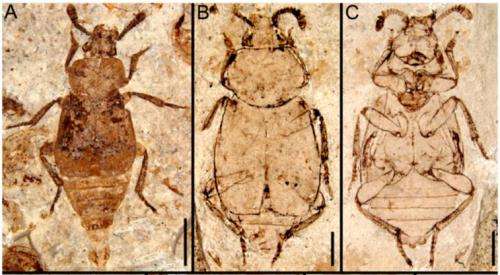September 16, 2014 report
Researchers find evidence of earliest instance of parental care in scavenger beetle

(Phys.org) —A team of researchers with members from the U.S., Germany and China has found evidence of parental care in a scavenger beetle fossil dated back to 125 million years ago, making it the earliest example of its kind. In their paper published in Proceedings of the National Academy of Sciences, the researchers describe their work in studying various beetle fossil specimens found in several parts of China and what they uncovered in doing so.
Many species of scavenger or carrion beetles alive today exhibit instances of parental care—what they have in common are stridulatory files—finely ridged surfaces that are used for making sounds when some sort of scraper or plectrum is dragged across it—the most well known example of an insect with such structures in modern times are crickets. With modern scavenger beetles, the stridulatory files are located on the abdomen and are known to be used as a communications mechanism between adults and offspring—to warn of danger, for example, or to alert them to an action that should be taken, i.e. forms of parental care.
In their studies, the researchers analyzed 37 silphid fossil specimens from two different biota environments across China and Myanmar including several that were preserved in amber. Using an electron microscope, the researchers analyzed the abdomens of the fossils and determined that specimens from 165 million years ago, did not have stridulatory files—suggesting they did not communicate with their offspring, and thus likely did little to care for them. Those that were 125 million years old, on the other hand, silphids of the Cretaceous, did have stridulatory files, which suggested they did communicate with their young, and thus likely offered some degree of care. More recent specimens, those from approximately 99 million years ago that were embedded in amber also had lamellate antennae, similar to modern burying beetles which suggest they likely were burying beetles as well—burying rodents or birds to provide food for their larvae.
The researchers note that current theory suggests caring for young is likely a precursor towards social behavior—because of that, learning more about when caring for young evolved helps plot social evolution as well.
More information: Early origin of parental care in Mesozoic carrion beetles, PNAS, Chen-Yang Cai, DOI: 10.1073/pnas.1412280111
Abstract
The reconstruction and timing of the early stages of social evolution, such as parental care, in the fossil record is a challenge, as these behaviors often do not leave concrete traces. One of the intensely investigated examples of modern parental care are the modern burying beetles (Silphidae: Nicrophorus), a lineage that includes notable endangered species. Here we report diverse transitional silphids from the Mesozoic of China and Myanmar that provide insights into the origins of parental care. Jurassic silphids from Daohugou, sharing many defining characters of Nicrophorinae, primitively lack stridulatory files significant for parental care communications; although morphologically similar, Early Cretaceous nicrophorines from the Jehol biota possess such files, indicating that a system of parental care had evolved by this early date. More importantly, burying beetles of the genus Nicrophorus have their earliest first record in mid-Cretaceous Burmese amber, and document early evolution of elaborate biparental care and defense of small vertebrate carcasses for their larvae. Parental care in the Early Cretaceous may have originated from competition between silphids and their predators. The rise of the Cretaceous Nicrophorinae implies a biology similar to modern counterparts that typically feed on carcasses of small birds and mammals.
Journal information: Proceedings of the National Academy of Sciences
© 2014 Phys.org





















